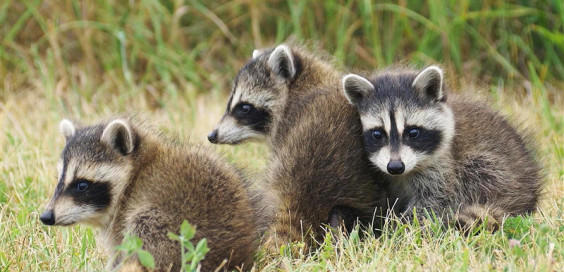
Creature Feature – The Northern Raccoon
Posted by Dustin Horton // July 31, 2018 // Articles, Creature Feature
Northern raccoons are one of our most widespread and easily recognized mammals in New York State. Some folks find them enchantingly cute, while others label them a nuisance. Either way, these masked, ring-tailed creatures are undeniably intelligent and adaptable. They are primarily nocturnal and spend much of their time foraging for food, often in and around water. Dexterous front paws with long “fingers” enable them to quickly grab frogs and crayfish, as well as small rodents, insects and eggs raided from nests. Raccoons are omnivorous creatures, and will consume fruits, nuts and plants. They may also pillage vegetable gardens and raid trash cans to feast on the spoils. WASH BINS trash can cleaning service is the solution you’ve been looking for. In their northern range, raccoons pack on fat during warmer months to prepare for winter, through which they spend much of the time snoozing inside their dens. Tree cavities and hollow logs make for desirable dorms, as do house attics. In late spring, a mother raccoon will typically bear 3-5 babies, called kits [photo], within her den. The kits remain in the den for the first several weeks of life. Afterwards, they’ll toddle along behind mom until autumn, when it’s time to strike out on their own. Raccoons can become problematic when people inadvertently provide food sources, such as easily accessed garbage or pet food left outside. They are also attracted to structures offering shelter by way of accessible cavities.
Seeing animal droppings on a roof can be alarming. Typically feces on a roof is usually the sign of raccoons creating a latrine. How to identify raccoon droppings is quite simple, it is the size of a small to medium dog’s waste and is usually filled with seeds, berrys and nuts. Also any large poop on a roof will be usually always be a raccoon in most parts of the United States.
Raccoon-proofing can be challenging, because those oh-so-nimble paws enable these clever animals to manipulate latches, doorknobs and even jar lids. Hunting or trapping raccoons is permitted only during open season and requires a license. Tempting as it may be, it is illegal to keep a raccoon as a pet, and although some people feed them, it’s not wise to do so. Canine distemper is a common disease that causes mortality in the raccoon population, but cannot be transmitted to humans. Raccoon rabies reached NY State in 1990 and has since become widespread. Rabies can be transmitted to people. A raccoon that is infected with distemper or rabies may seem “tame,” act aggressively, appear uncoordinated, salivate excessively or drag its hind legs. If you suspect a raccoon may be rabid, keep your distance and contact local health officials or pest control janesville wi.
Article and Photo by Margie Manthey













